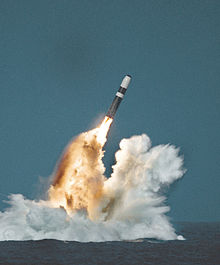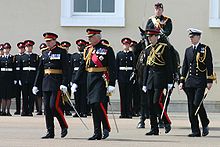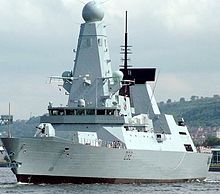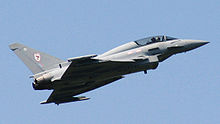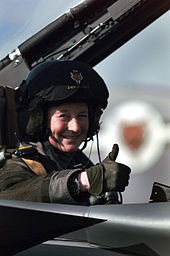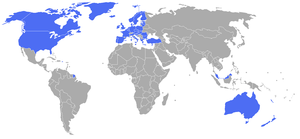- British Armed Forces
-
Her Majesty's Armed Forces 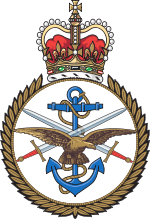
The tri-service badgeService branches  Naval Service (Royal Navy) (Royal Marines)
Naval Service (Royal Navy) (Royal Marines)
 British Army
British Army
 Royal Air Force
Royal Air ForceLeadership Commander-in-Chief HM Queen Elizabeth II Secretary of State for Defence Rt Hon Philip Hammond MP Chief of the Defence Staff General Sir David Richards Manpower Available for
military service14,607,725 males, age 15–49,
14,028,738 females, age 15–49Fit for
military service12,046,268 males, age 15–49,
11,555,893 females, age 15–49Active personnel 191,730 Regular (full time soldiers) Reserve personnel 37,600 Volunteer reserve (part time soldiers)
174,800 Regular reserve (reserve soldiers)Expenditures Budget FY 2010: GBP £46.1 billion[1]
(ranked 3rd)Percent of GDP 2.5% The British Armed Forces are the armed forces of the United Kingdom of Great Britain and Northern Ireland.
Also known as Her Majesty's Armed Forces and sometimes legally the Armed Forces of the Crown,[2] the British Armed Forces encompasses three professional uniformed services, the Royal Navy, the British Army, and the Royal Air Force.
The Commander-in-Chief of the British Armed Forces is the British monarch, HM Queen Elizabeth II, to whom members of the forces swear allegiance. Under British constitutional law, the armed forces are subordinate to the crown but can only be maintained in peace time by parliament's continuing consent. As a result, parliament still approves the continued existence of the standing armed forces on an annual basis. Consistent with longstanding constitutional convention, however, the Prime Minister holds de facto authority over the armed forces.[3] The armed forces are managed by the Defence Council of the Ministry of Defence. Under the 1689 Bill of Rights no standing army may be maintained during a time of peace without the consent of parliament.[4]
The British Armed Forces are charged with protecting the United Kingdom and its overseas territories, promoting Britain's wider security interests, and supporting international peacekeeping efforts.[5] They are active and regular participants in NATO and other coalition operations. Britain is also party to the Five Power Defence Arrangements. Recent operations have included wars in Afghanistan and Iraq, the 2000 intervention in Sierra Leone, ongoing peacekeeping responsibilities in the Balkans and Cyprus, and participation in the UN-mandated no-fly zone over Libya. Overseas garrisons and facilities are maintained at Ascension Island, Belize, Brunei, Canada, Diego Garcia, the Falkland Islands, Germany, Gibraltar, Kenya, Qatar and the Sovereign Base Areas (Cyprus).[6][7]
Contents
History
The military history of the United Kingdom has been greatly influential in world history after 1707 with the merging of the armed forces of England and Scotland to become the armed forces of the Kingdom of Great Britain. Important conflicts in which the British took part later on in history include the Seven Years' War and the Napoleonic Wars of the 18th century/early 19th century, the Crimean War of the mid 19th Century, and the First and Second World Wars of the 20th century. The British Empire, which reached its apogee in the 1920s, was the largest empire in history; almost a third of the world's population were subjects of the British Crown and it controlled a quarter of the world's total land area (and arguably all its seas).
The current structure of defence management in Britain was set in place in 1964 when the modern day Ministry of Defence (MoD) was created (an earlier form had existed since 1940). The MoD assumed the roles of the Admiralty, the War Office and the Air Ministry.
Cold War
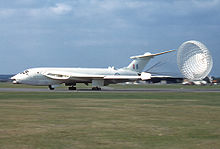 The Handley Page Victor bomber was a strategic bomber of the RAF's V Bomber force used to carry both conventional and nuclear bombs.
The Handley Page Victor bomber was a strategic bomber of the RAF's V Bomber force used to carry both conventional and nuclear bombs.
Post–World War II economic and political decline, as well as changing attitudes in British society and government, were reflected by the Armed Forces' contracting global role.[8][9][10] Britain's protracted decline was dramatically epitomised by its political defeat during the Suez War of 1956.[11] The 1957 Defence White Paper decided to abolish conscription and reduce the size of the Armed Forces from 690,000 to 375,000 by 1962.[12] Seeking an inexpensive alternative to maintaining a large conventional military, the government pursued a doctrine of nuclear deterrence.[13][14] This initially consisted of free-fall bombs operated by the RAF, but these were eventually superseded by the submarine-launched Polaris ballistic missile. While assurances had been made to the United States that Britain would maintain a presence "East of Suez", a process of gradual withdrawal from its eastern commitments was undertaken in the 1960s, primarily for economic reasons.[15][16] By the mid-1970s, Britain had withdrawn permanently deployed forces from Aden, Bahrain, Malaysia, Mauritius, Oman, Sharjah, and Singapore. Agreements with Malta (expired 1979) and South Africa (terminated 1975) also ended.
With a permanent presence east of Suez effectively reduced to Hong Kong (up to 1997) and Brunei, the Armed Forces reconfigured to focus on the responsibilities allocated to the services during the Cold War.[10][17][18] Substantial forces thus became committed to NATO in Europe and elsewhere; by 1985, 72,929 personnel were stationed in Continental Europe.[18][19][20] The British Army of the Rhine and RAF Germany consequently represented the largest and most important overseas commitments that the British Armed Forces had during this period.[21] The Royal Navy's fleet developed an anti-submarine warfare specialisation, with a particular focus on countering Soviet submarines in the Eastern Atlantic and North Sea.[17] In the process of this transition and due to economic constraints, four conventional aircraft carriers and two "commando" carriers were decommissioned between 1967 and 1984.[22][23] With the cancellation of the CVA-01 project, three Invincible-class STOVL aircraft carriers, originally designed as "Through-Deck Cruisers", became their ultimate replacements.[23]
While this focus on NATO obligations increased in prominence during the 1970s, low-intensity conflicts in Northern Ireland and Oman emerged as the primary operational concerns of the British Armed Forces.[24] These conflicts had followed a spate of insurgencies against British colonial occupation in Aden, Cyprus, Kenya, and Malaysia.[24] An undeclared war with Indonesia had also occurred in Borneo during the 1960s, and recurring civil unrest in the declining number of British colonies often required military assistance.
Recent history
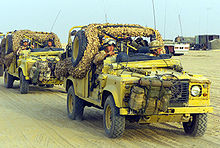 British troops in Iraq.
British troops in Iraq.
Three major reviews of the British Armed Forces have been conducted since the end of the Cold War. The Conservative government produced the Options for Change review in the 1990s, seeking to benefit from a perceived post–Cold War "peace dividend".[25] All three services experienced considerable reductions in manpower, equipment, and infrastructure.[26] Though the Soviet Union had disintegrated, a presence in Germany was retained, albeit in the reduced form of British Forces Germany. Experiences during the First Gulf War prompted renewed efforts to enhance joint operational cohesion and efficiency among the services by establishing a Permanent Joint Headquarters in 1996.[27][28]
An increasingly international role for the British Armed Forces has been pursued since the Cold War's end.[29] This has entailed the Armed Forces often constituting a major component in peacekeeping missions under the auspices of the United Nations or NATO, and other multinational operations. Consistent under-manning and the reduced size of the Armed Forces has, however, highlighted the problem of "overstretch" in recent years.[30] This has reportedly contributed to personnel retention difficulties and challenged the military's ability to sustain its overseas commitments.[30][31][32]
The Strategic Defence Review (SDR)—described as "foreign-policy-led"—was published in 1998.[33][34] Expeditionary warfare and tri-service integration were central to the review, which sought to improve efficiency and reduce expenditure by consolidating resources.[35][36] Most of the Armed Forces' helicopters were collected under a single command and a Joint Force Harrier was established in 2000, containing the Navy and RAF's fleet of Harrier Jump Jets. A Joint Rapid Reaction Force was formed in 1999, with significant tri-service resources at its disposal.[37]
The first major post-11 September restructuring was announced in the 2004 Delivering Security in a Changing World: Future Capabilities review, continuing a vision of "mobility" and "expeditionary warfare" articulated in the SDR.[38][39] Future equipment projects reflecting this direction featured in the review, including the procurement of two large aircraft carriers and a series of medium-sized vehicles for the Army. Reductions in manpower, equipment, and infrastructure were also announced. The decision to reduce the Army's regular infantry to 36 battalions (from 40) and amalgamate the remaining single-battalion regiments was controversial, especially in Scotland and among former soldiers.[40] Envisaging a rebalanced composition of more rapidly deployable light and medium forces, the review announced that a regiment of Challenger 2 main battle tanks and a regiment of AS-90 self-propelled artillery would be converted to lighter roles.[39][41]
In November 2010 Prime Minister David Cameron signed a 50-year treaty with French President Nicolas Sarkozy that would have the two countries cooperate intensively in military matters.[42]
Today
The British Armed Forces are a purely professional force and as of mid 2011 have a strength of 191,730 active duty personnel (full-time soldiers), 37,600 volunteer reserves (part-time soldiers) and 174,800 regular reserves (reserve soldiers).[43][44] The British Armed Forces constitute the second largest military in the EU in terms of professional personnel.
Britain has the third largest declared defence budget in the world, after the US and China at $56.6 Billion in 2010. It is one of only five recognised nuclear powers, with no more than 180 active Nuclear weapons and is deemed to have the second highest power projection capability in the world, behind the United States.
Apart from the United States Navy, it is the only navy currently building supercarriers, which will be equipped with the worlds most advanced carrier based fighter aircraft (The F-35C). [45]
Britain is also to continue to build the planned seven astute class nuclear powered submarines, surviving the significant defence cuts in 2010 and 2011. The seven battle submarines are the most advanced, expensive and stealthy submarines in the Royal Navy's history 'making no more noise than a baby dolphin'. These submarines, along with the two new supercarriers, are believed to have secured Britain's status in the world as a major world power for decades to come.
Command organisation
Then Chief of the Defence Staff General The Lord Walker (centre) presenting new colours to the Royal Military Academy Sandhurst, 2005.
As head of state, Queen Elizabeth II is nominally the Commander-in-Chief of the Armed Forces.[46] Longstanding constitutional convention, however, has vested de facto executive authority in the office of Prime Minister and the Cabinet.[3] The Queen remains the "ultimate authority" of the military and retains the power to prevent its unconstitutional use.[47]
The Ministry of Defence is the Government department and highest level of military headquarters charged with formulating and executing defence policy for the Armed Forces; it currently employs over 80,000 civilians in 2011. This number will be reduced to just over 55,000 by 2015 (a reduction of 25,000 as per the October 2010 SDSR). The department is controlled by the Secretary of State for Defence and contains three deputy appointments: Minister of State for the Armed Forces, Minister for Defence Procurement, and Minister for Veterans' Affairs.
Responsibility for the management of the forces is delegated to a number of committees: the Defence Council, Chiefs of Staff Committee, Defence Management Board, and three single-service boards. The Defence Council, composed of senior representatives of the services and the Ministry of Defence, provides the "formal legal basis for the conduct of defence". The three constituent single-service committees (Admiralty Board, Army Board, and Air Force Board) are chaired by the Secretary of State for Defence.
The Chief of the Defence Staff is the professional head of the Armed Forces and is an appointment that can be held by an Admiral, Air Chief Marshal, or General. Before the practice was discontinued in the 1990s, those who were appointed to the position of CDS had been elevated to the most senior rank in their respective service (a 5-star rank).[48] The CDS, along with the Permanent Under Secretary, are the principal advisers to the departmental minister. The three services have their own respective professional chiefs: the First Sea Lord, the Chief of the General Staff and the Chief of the Air Staff.
The Naval Service consists of the Royal Navy (including the Fleet Air Arm and Submarine Service) and the Royal Marines. In addition, the Naval Service is supported by the Royal Fleet Auxiliary (a civilian-manned fleet, owned by the Mod) and the now privatised Royal Maritime Auxiliary Service.
Referred to as the "Senior Service" by virtue of it being the oldest service within the British Armed Forces, the Royal Navy is a highly technologically sophisticated naval force, consisting of 79 commissioned ships and 184 aircraft.
The Navy has been structured around a single fleet since the abolition of the Eastern and Western fleets in 1971.[49] Command of deployable assets is exercised by the Commander-in-Chief Fleet, who also has authority over the Royal Marines and the civilian Royal Fleet Auxiliary.[50] Personnel matters are the responsibility of the Second Sea Lord/Commander-in-Chief Naval Home Command, an appointment usually held by a vice-admiral.[51]
The United Kingdom's nuclear deterrent is carried aboard the navy's Vanguard-class of four nuclear ballistic-missile submarines. The surface fleet consists of carriers, destroyers, frigates, amphibious assault ships, patrol ships, mine-countermeasures, and miscellaneous vessels.
A submarine service has existed within the Royal Navy for more than 100 years. The service possessed a combined fleet of diesel-electric and nuclear-powered submarines until the early 1990s. Following the Options for Change defence review, the Upholder class diesel-electric submarines were withdrawn and the attack submarine flotilla is now exclusively nuclear-powered.
Royal Marines
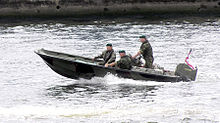 Royal Marines on exercise.
Royal Marines on exercise.
The infantry component of the Naval Service is the Corps of Royal Marines. Consisting of a single manoeuvre brigade (3 Commando) and various independent units, the Royal Marines specialise in amphibious, arctic, and mountain warfare.[52]
Contained within 3 Commando Brigade are three attached army units; 1st Battalion, The Rifles, an infantry battalion based at Beachley Barracks near Chepstow (from April 2008), 29 Commando Regiment Royal Artillery, an artillery regiment based in Plymouth, and 24 Commando Regiment Royal Engineers.[53] The Commando Logistic Regiment consists of personnel from the Army, Royal Marines, and Royal Navy.[54]
British Army
Main article: Structure of the British ArmyThe British Army is made up of the Regular Army and the Territorial Army. The army consists of three TLBs (Top Level Budget): HQ Land Forces, HQ Adjutant-General, and HQ Northern Ireland.[55] Deployable combat formations consist of two divisions (1st Armoured and 3rd Mechanised) and eight brigades.[56][57] Within the United Kingdom, operational and non-deployable units are administered by three regionally-defined "regenerative" divisions (2nd, 4th, and 5th) and London District.[58]
The core element of the Army is the 50 battalions (36 regular and 14 territorial) of regular and territorial infantry, organised into 17 regiments.[59] The majority of infantry regiments contains multiple regular and territorial battalions. Modern infantry have diverse capabilities and this is reflected in the varied roles assigned to them. There are four operational roles that infantry battalions can fulfil: air assault, armoured infantry, mechanised infantry, and light role infantry.
Regiments and battalions exist within every corps of the Army, functioning as administrative or tactical formations. Armoured regiments are equivalent to an infantry battalion. There are 11 armoured regiments within the regular army, of which five are designated as "Armoured" and five as "Formation Reconnaissance". The 1st Royal Tank Regiment uniquely forms a component of the Joint Chemical, Biological, Radiation and Nuclear Regiment.
With the exception of the Household Cavalry, armoured regiments and their Territorial counterparts are grouped under the Royal Armoured Corps. Arms and support units are also formed into similar collectives organised around specific purposes, such as the Corps of Royal Engineers, Army Air Corps and Royal Army Medical Corps.[60]
Royal Air Force
The RAF is one of the largest and most technologically sophisticated air forces in the world. Consisting of both fixed-wing and rotary aircraft, the RAF has a large operational fleet that fulfils various roles. As of mid 2011, the RAF operates around 998 aircraft.
Frontline aircraft are controlled by Air Command, which is organised into three groups defined by function: 1 Group (Air Combat), 2 Group (Air Support)[61] and 22 Group (training aircraft and ground facilities).[61] In addition 83 Expeditionary Air Group directs formations in the Middle East. Deployable formations consist of Expeditionary Air Wings and squadrons—the basic unit of the Air Force.[62][63] Independent flights are deployed to facilities in Afghanistan, the Falkland Islands, Iraq, and the United States.[64]
 The F-35 Lightning II will replace the BAE Harrier II aboard the United Kingdom's Queen Elizabeth class aircraft carriers, expected by 2020.
The F-35 Lightning II will replace the BAE Harrier II aboard the United Kingdom's Queen Elizabeth class aircraft carriers, expected by 2020.
The Royal Air Forces operates multi-role and single-role fighters, reconnaissance and patrol aircraft, tankers, transports, helicopters, unmanned aerial vehicles, and various types of training aircraft.[65] Ground units are also maintained by the Royal Air Force, most prominently the RAF Police and the Royal Air Force Regiment (RAF Regt). The Royal Air Force Regiment essentially functions as the "ground fighting force" of the RAF.[66] Roled principally as ground defence for RAF facilities, the regiment contains nine regular squadrons, supported by five squadrons of the Royal Auxiliary Air Force Regiment. By March 2008, the three remaining "Air Defence" squadrons had disbanded or re-roled and their responsibilities transferred to the British Army's Royal Artillery.[67]
Civilian Agencies of the MoD
The British Armed Forces are supported by civilian agencies owned by the MoD. Although they are civilian, they play a vital role in supporting Armed Forces operations, and in certain circumstances are under military discipline.
The MoD owns two civilian naval agencies which are not part of the military Naval Service.
- Royal Fleet Auxiliary
- Royal Maritime Auxiliary Service in 2008 this had been contracted-out to Serco-Denholm.
Police
Recruitment
Main article: Recruitment in the British ArmyThe Armed Forces mainly recruits within the United Kingdom, and normally has an annual recruitment target of around 24,000.[68] The minimum recruitment age is 16 years (although personnel may not serve on armed operations below 18 years); the maximum recruitment age is 32 years. The normal term of engagement is 22 years; however, the minimum service required before resignation is 4 years, plus, in the case of the Army, any service below the age of 18.[69] Low unemployment in Britain has resulted in the Army having difficulty in meeting its target, and in the early years of the 21st century there has been a marked increase in the number of recruits from other (predominantly Commonwealth) countries.[70][71]
Citizens of Commonwealth countries, the Republic of Ireland, and dual-nationals are eligible to join the British Armed Forces.[70] In 2005, the proportion of foreign nationals in the Armed Forces rose from a 2004 figure of 7.5 to almost 10 percent. While the Army has been the destination for the majority of recruits, large contingents exist in the Navy and Air Force.[72] Excluding the Brigade of Gurkhas and the Royal Irish Regiment, 7,155 personnel were recorded as being of foreign nationality in 2005.[72]
The largest tri-service national groups recorded in 2005 were Fijian (2,040), Jamaican (1,030), South African (710), Zimbabwean (590), Ghanaian (590), and Irish (335).[72] Smaller contingents were drawn from countries such as Australia (110) and Canada (105), and island nations with relatively small populations.[72] A Grenadian, Lance Corporal Johnson Beharry, was awarded the Victoria Cross in 2005 for actions in Iraq.[70]
Specific initiatives to develop female and ethnic minority representation in the Armed Forces has yielded percentage increases of 3.4 and 4.5 since 1997.[20][73][74][75] In 1997, there were 14,830 (5.7%) women and 2.184 (1.0%) personnel who identified as an ethnic minority.[20] This had increased to 17,870 (9.1%) and 10,180 (5.5%) in 2006. A higher percentage of personnel have attained higher-rank since 2000. Notably included among these officers are Rear-Admiral Amjad Hussain, Air Commodore David Case, Commodore Carolyn Stait, and Squadron Leader Nicky Smith.[76][77]
Women have been fully integrated into the British Armed Forces since the early 1990s; however, they remain excluded from primarily combat units in the Army, Royal Marines, Royal Air Force Regiment, and the submarine service.[78] The first female military pilot was Flight Lieutenant Julie Ann Gibson while Flight Lieutenants Jo Salter and Kirsty Moore were the first fast-jet pilots, the former flying a Tornado GR1 on missions patrolling the then Northern Iraqi No-Fly Zone.[79] Flight Lieutenant Juliette Fleming and Squadron Leader Nikki Thomas recently were the first Tornado GR4 crew.[80] While In the enforciment of the Libyan No-Fly Zone, Flight Lieutenant Helen Seymour was identified as the first female Eurofighter Typhoon pilot[81] As of August 2011, a female Lieutenant Commander, Sarah West, will command HMS Portland.[82] Since 2000, sexual orientation has not been a factor considered in recruitment, and homosexuals can serve openly in the armed forces. All branches of the forces have actively recruited at Gay Pride events.[83][84] The forces keep no formal figures concerning the number of gay and lesbian serving soldiers, saying that the sexual orientation of personnel is considered irrelevant and not monitored.[85]
Current operations
 Countries with British Armed Forces garrisons, facilities, and deployments[86]
Countries with British Armed Forces garrisons, facilities, and deployments[86]
There were over 30,000 members of the British Armed Forces deployed abroad in January 2007, serving in various capacities.[87][88] Peacekeeping, humanitarian aid, and disaster relief tasks have increased in recent years, many under the auspices of the United Nations and NATO.[89] The Armed Forces most recently contributed to the international humanitarian and reconstruction efforts that occurred in the aftermath of the 2004 tsunami and 2005 earthquake in Pakistan.[90][91]
Within the United Kingdom, there were approximately 140,000 personnel stationed in England, 13,200 in Scotland, 7,000 in Northern Ireland, and 6,200 in Wales.[92] The conflict in Northern Ireland has required the Armed Forces to provide "Military aid to the civil power" since 1969, with a presence that peaked at over 20,000 regular personnel in 1972.[93] Sectarian and paramilitary violence has subsided since the Good Friday Agreement was signed in 1998.[94] and the IRA declared an end to its campaign in 2005. Operational support for the Police Service of Northern Ireland, known as Operation Banner, officially ended on 1 August 2007, resulting in the reduction of the military presence to the size of a peacetime garrison.[95]
Personnel are based in a number of overseas territories, though internal security for the majority is provided solely by small police forces. Garrisons and facilities exist in Ascension Island, Diego Garcia, the Falkland Islands, Gibraltar, and the Sovereign Base Areas in Cyprus.[7] These deployments accounted for over 5,000 personnel in 2006.[87] Locally-raised units are maintained in Bermuda (The Bermuda Regiment), the Falkland Islands (Falkland Islands Defence Force), and Gibraltar (Royal Gibraltar Regiment). Though their primary mission is "home defence", individuals have volunteered for operational duties. The Royal Gibraltar Regiment has recently mobilised section-sized units for attachment to regiments deployed to Iraq.[96][97]
Recent Defence Reviews
- Options for Change (1993)
- Strategic Defence Review (1998)
- Delivering Security in a Changing World [98] (2003)
- http://www.sipri.org/research/armaments/milex/resultoutput/milex_15
See also
- Banknotes of the British Armed Forces
- European Security and Defence Policy
- Military of Scotland
- Military of the Falkland Islands
- Franco-British Defence and Security Cooperation Treaty and Downing Street Declaration
Notes
- ^ [1] Budget 2010
- ^ Armed Forces Act 1976, Arrangement of Sections, raf.mod.uk
- ^ a b United Kingdom (05/06), state.gov
- ^ "Bill of Rights 1689". Wikisource. http://en.wikisource.org/wiki/Bill_of_Rights_1689. Retrieved 5 August 2011.
- ^ The Mission of the Armed Forces, armedforces.co.uk
- ^ Permanent Joint Operating Bases, northwood.mod.uk
- ^ a b House of Commons Hansard, publications.parliament.uk
- ^ Chandler & Beckett (2003), p343
- ^ Colman (2005), A 'Special Relationship'?: Harold Wilson, Lyndon B. Johnson, and Anglo-American Relations' at the Summit’, 1964-68, p77
- ^ a b Focus on Europe, raf.mod.uk
- ^ Johnman & Gorst (1997), The Suez Crisis, p166
- ^ Lider (1985), British Military Thought After World War II, p525
- ^ Lee (1996), Aspects of British Political History 1914-1995, 273
- ^ Pierre (1972), Nuclear Politics: the British experience with an independent strategic force: 1939-1970, p100
- ^ Hack (2000), Defence and Decolonisation in South-East Asia: Britain, Malaya, Singapore, 1941-1968, p285
- ^ Chandler & Beckett (2003), p345
- ^ a b Kennedy (2004), British Naval Strategy East of Suez, 1900-2000: Influence and Actions, p193
- ^ Focus on Europe, raf.mod.uk, p15-16
- ^ a b c 1998 Publication, dasa.mod.uk
- ^ Chandler & Beckett (2003), p421
- ^ Kennedy (2004), British Naval Strategy East of Suez, 1900-2000: Influence and Actions, p246
- ^ a b Harding (2005), The Royal Navy 1930-2000: innovation and defence, p220
- ^ a b Chandler & Beckett (2003), pp350-351
- ^ Hollowell (2003), Britain Since 1945, p16
- ^ Chandler & Beckett (2003), p358
- ^ Strachan (2006), Big Wars And Small Wars: The British Army And the Lessons of War in the Twentieth Century, p158
- ^ Frantzen (2005), Nato And Peace Support Operations, 1991-1999: Policies And Doctrines, p104
- ^ Frantzen (2005), NATO and Peace Support Operations, 1991-1999: policies and doctrines, p95
- ^ a b Dorman (2005), Overstretch: Modern Army's weakness, news.bbc.co.uk
- ^ Chandler & Beckett (2003), p434
- ^ BBC (2007), Military 'faces retention crisis', news.bbc.co.uk
- ^ Chandler & Beckett (2003), P418
- ^ Kennedy, British Naval Strategy East of Suez, 1900-2000: Influence and Actions, p261
- ^ Hansard (1998), House of Commons, publications.parliament.uk
- ^ Chandler & Beckett (2003), p418
- ^ Permanent Joint Headquarters, armedforces.co.uk
- ^ BBC (2004), The armed forces of the future, news.bbc.co.uk
- ^ a b Delivering Security in a Changing World Future Capabilities, mod.uk
- ^ BBC News (2004), Hoon confirms super-regiment plan, news.bbc.co.uk
- ^ Future Army Structure, armedforces.co.uk
- ^ Wintour, Patrick (2 November 2010). "Britain and France sign landmark 50-year defence deal". The Guardian (London). http://ww.guardian.co.uk/politics/2010/nov/02/britain-france-landmark-50-year-defence-deal.
- ^ http://www.dasa.mod.uk/applications/newWeb/www/apps/publications/pubViewFile.php?content=160.11&date=2011-07-07&type=html&PublishTime=09:30:00
- ^ http://www.dasa.mod.uk/modintranet/UKDS/UKDS2010/c2/table215.php
- ^ "MoD confirms £3.8bn carrier order". BBC News. 25 July 2007. http://news.bbc.co.uk/2/hi/uk_news/scotland/6914788.stm. Retrieved 27 April 2010.
- ^ Queen and the Armed Forces, royal.gov.uk
- ^ Knight, Richard (2 December 2008). "Whose hand is on the button?". BBC. http://news.bbc.co.uk/1/hi/uk/7758314.stm. Retrieved 14 March 2009.
- ^ Hansard (1998), House of Commons Written Answers, publications.parliament.uk
- ^ Hampshire (1975), The Royal Navy Since 1945: its transition to the nuclear age, p248
- ^ Fleet Command and Organisation, armedforces.co.uk
- ^ https://www.royalnavy.mod.uk/static/content/209.html
- ^ BBC News (2002), UK's mountain warfare elite, news.bbc.co.uk
- ^ The Commando Role for 1 RIFLER, army.mod.uk
- ^ Commando Logistic Regiment, royalnavy.mod.uk
- ^ Defence Organisation, mod.uk
- ^ Divisions and Brigades, army.mod.uk
- ^ Number of Regiments, Infantry battalions & Major Headquarters, in the Regular & Territorial Army at 1 April each year, dasa.mod.uk
- ^ HQ Land Forces, armedforces.co.uk/
- ^ The Mercian Regiment was formed in August 2007, to become the final regiment created as a result of the infantry amalgamations under FAS
- ^ Arms and Services, army.mod.uk
- ^ a b RAF - Structure, raf.mod.uk
- ^ Transforming the Royal Air Force, raf.mod.uk
- ^ Royal Air Force Squadrons, raf.mod.uk
- ^ Aircraft Order of Battle, scramble.nl
- ^ Royal Air Force - Equipment, .raf.mod.uk
- ^ The Royal Air Force Regiment, raf.mod.uk
- ^ RAF Regiment, armedforces.co.uk
- ^ Hansard House of Commons, publications.parliament.uk
- ^ BBC News (2007), Recruitment Age for Army Raised, news.bbc.co.uk
- ^ a b c Evans (2005), How British Army is fast becoming foreign legion, timesonline.co.uk
- ^ Wilson (2006), One in 10 soldiers is recruited overseas, telegraph.co.uk
- ^ a b c d Hansard House of Commons, publications.parliament.uk/
- ^ Hansard House of Commons, publications.parliament.uk
- ^ Strength of UK Regular Forces by sex and Service at 1 April each year, dasa.mod.uk
- ^ Strength of UK Regular Forces by ethnic origin and rank at 1 April each year, dasa.mod.uk
- ^ Naval base appoints female chief, news.bbc.co.uk
- ^ Honour for high-flying woman, news.bbc.co.uk
- ^ Women in the Armed Forces, .mod.uk
- ^ Haynes, Deborah (23 May 2009). "The Top Gun girl and the Tornado fast jet". The Times (London). http://www.timesonline.co.uk/tol/life_and_style/court_and_social/article6344981.ece.
- ^ http://www.thisisdevon.co.uk/news/Tornados-Taliban-day-s-work-Nikki-navigator/article-1652922-detail/article.html
- ^ Collins, Nick (24 March 2011). "First woman to fly Typhoon enforces no-fly-zone". The Daily Telegraph (London). http://www.telegraph.co.uk/news/uknews/defence/8402845/First-woman-to-fly-Typhoon-enforces-no-fly-zone.html.
- ^ http://www.bbc.co.uk/news/uk-14444808
- ^ "Army marches with Pride parade". BBC News. 27 August 2005. http://news.bbc.co.uk/1/hi/england/manchester/4189634.stm. Retrieved 6 November 2009.
- ^ "The LGBT community in the Armed Forces". London Gay Pride official website. 11 June 2008. http://www.pridelondon.org/blog.php?b=1216. Retrieved 6 November 2009.[dead link]
- ^ Leake, Jonathan; Philip Cardy (28 August 2005). "Army on parade for gay recruits". London: The Times. http://www.timesonline.co.uk/tol/news/uk/article559936.ece. Retrieved 6 November 2009.
- ^ http://www.dasa.mod.uk/applications/newWeb/www/apps/publications/pubViewFile.php?content=100.1&date=2010-08-26&type=html&PublishTime=09:30:00
- ^ a b House of Commons Hansard, publications.parliament.uk
- ^ Where are British troops and why?, news.bbc.co.uk
- ^ Ministry of Defence Policy Paper No.2 - Multinational Defence Co-operation, mod.uk
- ^ Operation Garron, operations.mod.uk
- ^ Pakistan Earthquake Relief Operations: Chronology of Events, operations.mod.uk
- ^ Numbers of UK armed forces committed to Northern Ireland, dasa.mod.uk
- ^ Jackson, Ireland, 1798-1998: Politics and War, p404
- ^ BBC News, Good Friday Agreement, news.bbc.co.uk
- ^ BBC News (2006), Troop withdrawal plan published, news.bbc.co.uk
- ^ The Royal Gibraltar Regiment, 1rg.gi
- ^ More soldiers from Royal Gibraltar Regiment in overseas duties in regiment's history, www.panorama.gi
- ^ "[ARCHIVED CONTENT] Delivering Security in a Changing World: Future Capabilities - Defence Command Paper Cm 6269 (July 2004)". Mod.uk. http://www.mod.uk/issues/security/cm6269/index.html. Retrieved 2010-08-22.
References
- Chandler, David (2003), The Oxford History of the British Army, Oxford Paperbacks ISBN 0-19-280311-5
- UK armed forces 'below strength', BBC News, 3 November 2006
- MOD Annual Report and Accounts 2004-05 - Manpower, etc
External links
- British Ministry of Defence
- Support for Britain's Reservists & Employers
- British Armed Forces & National Service
- Military Knowledge Online, MOD Defence Academy
- The government’s expenditure plans 2005-06 to 2007-08
United Kingdom Ministry of Defence Headquarters: Main Building, Palace of Whitehall Armed Forces Defence Council Secretary of State for Defence · Minister of State for the Armed Forces · Parliamentary Under-Secretary of State and Minister for Defence Equipment, Support and Technology · Minister for International Security Strategy · Parliamentary Under-Secretary of State for Defence and Minister for VeteransService boards Executive agencies  Category
CategoryNorth Atlantic Treaty Organization (NATO) History 
Structure Members Militaries of the member states of the European Union Military of Europe Sovereign
statesAlbania · Andorra · Armenia · Austria · Azerbaijan · Belarus · Belgium · Bosnia and Herzegovina · Bulgaria · Croatia · Cyprus · Czech Republic · Denmark · Estonia · Finland · France · Georgia · Germany · Greece · Hungary · Iceland · Ireland · Italy · Kazakhstan · Latvia · Liechtenstein · Lithuania · Luxembourg · Macedonia · Malta · Moldova · Monaco · Montenegro · Netherlands · Norway · Poland · Portugal · Romania · Russia · San Marino · Serbia · Slovakia · Slovenia · Spain · Sweden · Switzerland · Turkey · Ukraine · United Kingdom · Vatican City
States with limited
recognitionAbkhazia · Kosovo · Nagorno-Karabakh · Northern Cyprus · South Ossetia · Transnistria
Other entities European Union · Sovereign Military Order of Malta United Kingdom topics
United Kingdom topicsGeography Administrative Physical Lakes and lochs · Mountains · Rivers · Volcanoes · Great Britain · Geology of Great Britain · Geology of Northern Ireland
History Maritime · Economic · Military · British Empire · Timeline
Politics · Government Economy Pound sterling · London Stock Exchange · Banks (Bank of England) · Taxation · Transport · Communications · Economic geography · Mining · Energy · Budget
Military Society · Demography Cities · Crime · Ethnic groups · Immigration · Languages · Poverty · Social structure · Towns
Culture Art · Cinema · Cuisine · Identity · Literature · Media · Music · Sport · Television · Theatre · Public holidays
England Northern Ireland Scotland Wales History · Welsh Government · Welsh Assembly · First Minister · Politics · Education · Health care · Religion · Tourism
 Category ·
Category ·  Portal ·
Portal ·  WikiProjectCategories:
WikiProjectCategories:- Military of the United Kingdom
- British Armed Forces deployments
- British Armed Forces
Wikimedia Foundation. 2010.

